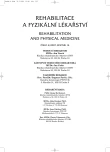Comparison of the Effect of the Post-isometric Relaxation and Manual Centration According to Čápová on the Trigger Points in Trapezoid Muscle in Cervical Pain Syndromes
Authors:
E. Pecková 1,2; R. Dvořák 1
Authors‘ workplace:
Fakulta tělesné kultury UP, katedra fyzioterapie, Olomouc
vedoucí katedry prof. MUDr. J. Opavský, CSc.
1; Rehabilitace, Český Těšín
vedoucí D. Suchanková
2
Published in:
Rehabil. fyz. Lék., 14, 2007, No. 4, pp. 147-154.
Category:
Original Papers
Overview
The goal of the thesis was the comparison of the effect of the postisometrical relaxation and manual centration according to Čápová on the trigger points in musculus trapezius when the patient suffers from cervical pain syndromes. The patients were divided into the groups A and B; group A was treated by postisometrical relaxation, and group B by manual centration according to Čápová. The trigger points were detected by the combination therapy. The combination therapy uses the different irritation of hypertonic fibers by electrical stimulus. The numeric value of the treshold motoric intensity was taken down before the therapy, after the therapy and the next day.
The thesis shows that both therapies work on a different neurofysiological basis but they have the same statistically significant effect on removing the trigger points in the muscles. The intent of the centration of shoulder is not treating the trigger points in the muscle; this is the focus of the postisometric relaxation. The removal of the trigger points is only a side effect of the centration, due to coactivation of muscles round the centration joint.
Key words:
centration of the shoulder, postisometric relaxation, trigger point, cervical pain syndromes
Sources
1. LEWIT, K.: Manuální medicína. Praha, Sdělovací technika, spol. s.r.o., 2003, s. 115-116, 231-237.
2. VÉLE, F.: Jandova hodnocení pohybové soustavy. Rehabilitácia, roč. 9, 1974, č. 7, s. 45-48.
3. TRAVELL, J. G., SIMONS, D. G.: Myofascial pain and dysfunction: The trigger point manual. Vol. 1, The upper extremities. Baltimore, Williams & Wilkins, 1982, pp. 183-201.
4. PODĚBRADSKÝ, J., VAŘEKA, I.: Fyzikální terapie I. Praha, Grada Publishing, 1997, s. 187-190.
5. URBAN, J.: Mechanismus účinku TENS - kombinovaná terapie utrazvuk a TENS- II. Fyzioterapie, 2001, č. 4, Retrieved 3. 4. 2004 from the World Wide Web: http://risc.upol.cz/~varek/pt/F/F4/TENSII.html.
6. ČÁPOVÁ, J.: Bazální programy ve fyzioterapii. 2005. [Učební texty ke stejnojmennému kurzu].
7. PODĚBRADSKÝ, J., VAŘEKA, I.: Fyzikální terapie II. Praha, Grada Publishing, 1997, s. 137.
8. KOLÁŘ, P.: Systematizace svalových dysbalancí z pohledu vývojové kineziologie. Rehabilitace a fyzikální lékařství, roč. 8, 2001, č. 4, s. 152-164.
Labels
Physiotherapist, university degree Rehabilitation Sports medicineArticle was published in
Rehabilitation & Physical Medicine

2007 Issue 4
- Hope Awakens with Early Diagnosis of Parkinson's Disease Based on Skin Odor
- Deep stimulation of the globus pallidus improved clinical symptoms in a patient with refractory parkinsonism and genetic mutation
Most read in this issue
- Rehabilitation in Oncology
- Comparison of the Effect of the Post-isometric Relaxation and Manual Centration According to Čápová on the Trigger Points in Trapezoid Muscle in Cervical Pain Syndromes
- Regression Changes of Ageing Organism thein Their Influence on Postural Stability
